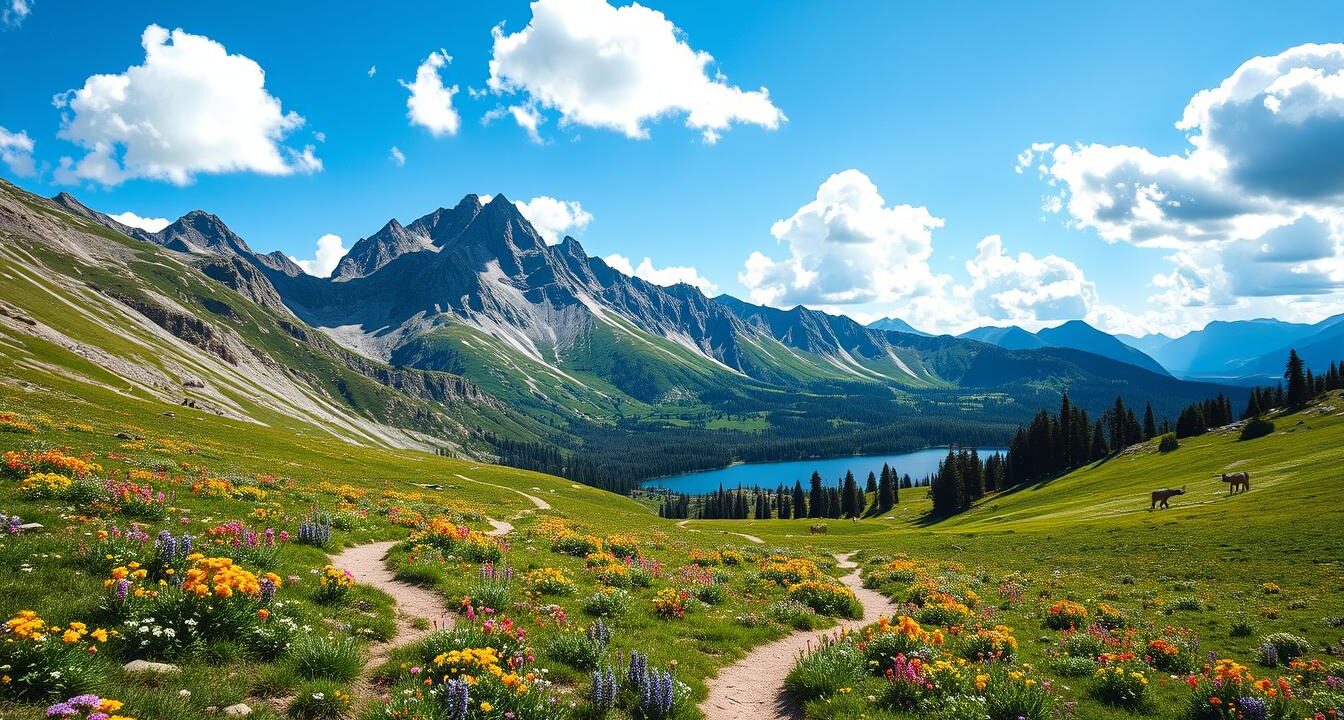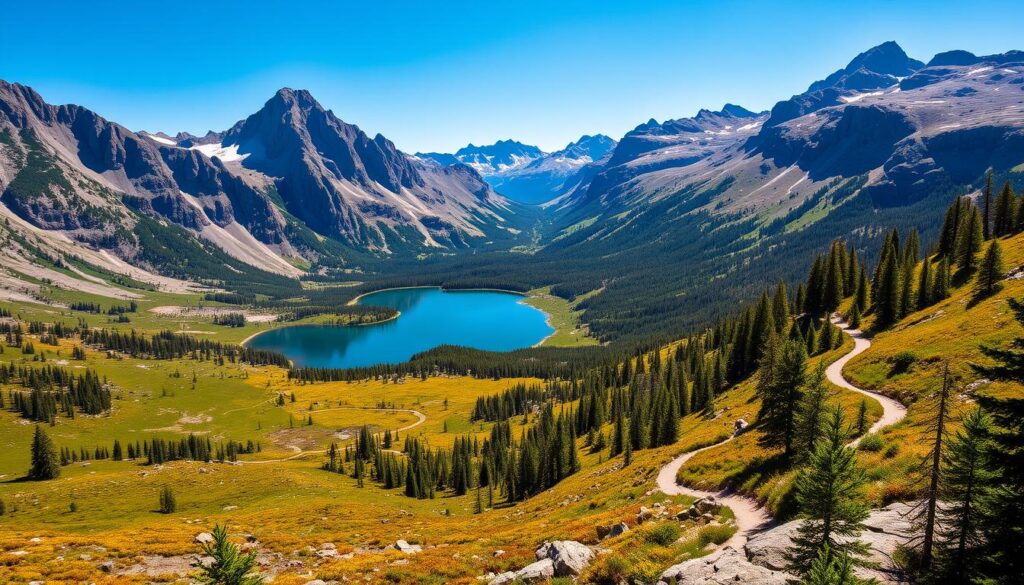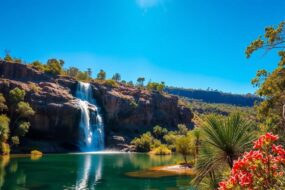
As I put on my hiking boots and looked up at the Rocky Mountains, I felt wonder and excitement. This was my first time in Rocky Mountain National Park. I was excited to see the famous hiking trails that many have loved for years.
The park’s beauty is famous for good reason. It has over 100,000 acres of wilderness, 118 peaks over 10,000 feet, and 147 beautiful lakes. Here, you can see waterfalls, alpine lakes, wildflower meadows, and amazing views. The trails promise a journey through some of the most stunning landscapes in the American West.
Key Takeaways
- Rocky Mountain National Park has over 355 miles of hiking trails for all skill levels.
- The park offers diverse landscapes, including waterfalls, lakes, cirques, and mountain views.
- There are trails for everyone, from beginners to experienced hikers.
- The park covers over 100,000 acres, with 118 peaks over 10,000 feet and 147 lakes.
- Rocky Mountain National Park was ranked #2 in America’s five most popular national parks for hiking in 2023 by Condé Nast Traveler.
Introduction to Rocky Mountain National Park’s Trail System
Rocky Mountain National Park is a gem in the Rocky Mountains. It has 355 miles of hiking trails. These trails take you from high peaks to calm alpine lakes. The park’s varied landscapes and heights cater to all hikers.
Overview of 355 Miles of Hiking Trails
The park’s trails are a dream for hikers. With over 355 miles, there’s a trail for every adventure. Whether you want a gentle walk or a tough climb, you’ll find it here.
Park Geography and Elevation Ranges
The park’s landscape is breathtaking, with elevations from 7,800 to 14,259 feet. You’ll see alpine lakes, waterfalls, and different ecosystems. It’s a chance to explore the Rocky Mountains’ wonders.
Best Seasons for Hiking
- Summer is peak season, with warm weather and clear skies. It attracts millions of visitors.
- Spring is alive with wildflowers. It’s a time to see the park come to life after winter.
- Fall is known for its colorful foliage. The aspen trees create a stunning view.
- Winter turns the park into a snowy paradise. It’s perfect for snowshoeing and skiing.
Every season in Rocky Mountain National Park offers unique experiences. Whether you’re hiking or just enjoying the views, it’s a place of beauty.
Essential Planning and Safety Guidelines
Going on a hike in Rocky Mountain National Park needs careful planning and attention. You must sign up for a timed entry and pay the park fees first. This is before you start your wilderness exploration or high-altitude trekking.
Getting a backcountry camping permit is key if you plan to camp overnight. Safety is a big deal, like getting used to the high altitude and watching the weather. Make sure you have the right gear for the terrain.
Knowing the trail conditions is important, especially after the 2020 East Troublesome and Cameron Lake fires. Start early to avoid afternoon storms and crowded trails. This way, you can enjoy the stunning Colorado Rockies scenery fully.
| Trail | Distance | Elevation Gain | Difficulty |
|---|---|---|---|
| Bear Lake Loop | 0.8 miles | 60 feet | Easy |
| Alberta Falls | 1.6 miles | 180 feet | Moderate |
| Emerald Lake | 3.6 miles | 700 feet | Moderate |
| Sky Pond | 9.5 miles | 1,800 feet | Challenging |
Think about the trail’s difficulty, elevation, and length when choosing. This helps match your fitness level and what you want to see in the Colorado Rockies. Being well-prepared, safe, and respectful of nature is essential for a great wilderness exploration in Rocky Mountain National Park.
Mountain Majesty: Discovering the Best Hikes in Rocky Mountain National Park
Rocky Mountain National Park is a paradise for outdoor lovers. It has over 355 miles of trails for hiking. You can walk through green forests or climb high mountains. The park has trails for everyone, from easy walks to tough climbs.
Looking for scenic landscapes, wilderness exploration, or high-altitude trekking? Rocky Mountain National Park has it all. It will inspire and amaze you.
Trail Difficulty Classifications
The park’s trails are sorted by how hard they are. Easy trails are short and not too steep. Moderate trails are longer and steeper. Strenuous trails are the toughest, with big climbs and long walks.
Signature Landscapes and Features
Walking the trails, you’ll see amazing sights. You’ll see alpine tundra, forests, and more. The park’s famous spots, like the Continental Divide and Longs Peak, make your hike special.
Wildlife Viewing Opportunities
The park is home to many animals. You might see elk, bighorn sheep, and marmots. These animals make hiking here even more exciting.
Rocky Mountain National Park has hikes for everyone. Whether you want a calm walk or a big challenge, you’ll find it here. The park’s beauty, wildlife, and high trails will amaze you.
Iconic Bear Lake Corridor Trails
The Bear Lake Corridor in Rocky Mountain National Park is a gem. It’s filled with beloved hiking trails. This area offers trails for everyone, from easy walks to tough climbs, all surrounded by stunning views.
The Bear Lake Trail is a favorite. It’s a short half-mile loop with a small elevation gain. It’s great for those new to hiking. The Emerald Lake Trail is a bit longer, at 3 miles, with a bigger elevation gain. It takes you to Emerald Lake and offers amazing views.
The Lake Halyaha Trail is another option. It’s 3.5 miles long and has a big elevation gain. It shows off the park’s glacial landscapes. The Bear Lake Road is 9 miles long and leads to the Bear Lake Trailhead. But, parking lots fill up fast in summer.
Winter brings its own charm to the Bear Lake Corridor. Snowshoeing and skiing are great ways to see the park in snow. It’s a peaceful way to explore.
No matter the season, the Bear Lake Corridor is a must-see. It offers incredible views and hiking for all. Whether you want a simple walk or a tough hike, this place is unforgettable.
Alpine Lake Adventures: Dream Lake and Emerald Lake Circuit
In the heart of Rocky Mountain National Park, a special circuit awaits. It’s filled with backcountry experiences and scenic landscapes. The Dream Lake and Emerald Lake trail is a unique wilderness exploration. It offers stunning views and perfect spots for photography.
Dream Lake Trail Highlights
The Dream Lake trail is 3.6 miles out and back, starting at 9,489 feet. It offers amazing views of Nymph Lake and Longs Peak. The trail goes through lush forests, where you might see elk, moose, and other wildlife.
Emerald Lake Vista Points
The trail leads to Emerald Lake, at 10,154 feet. Here, you can see Tyndall Glacier, Hallett Peak, and Flattop Mountain. The 698-foot climb to Emerald Lake is moderate, but the views are worth it.
Photography Opportunities
- Capture the first light of day illuminating the peaks during sunrise
- Experiment with long exposures to create dreamy reflections on the alpine lakes
- Immortalize the vibrant wildflowers that dot the landscape in summer
The Dream Lake and Emerald Lake circuit is a mix of backcountry experiences, scenic landscapes, and wilderness exploration. It’s perfect for both seasoned hikers and nature lovers. This trail will leave you with unforgettable memories and a deeper love for nature.
| Trail Information | Details |
|---|---|
| Hike Distance | 3.6 miles out and back |
| Elevation | Trailhead: 9,489 ft, Emerald Lake: 10,154 ft |
| Elevation Gain | 665 ft |
| Duration | Approximately 2 hours |
| Timed Entry Reservations | Required from May 24 to Oct 20, 2024, 5 am to 6 pm |
| Reservation Fee | $2 nonrefundable |
| Trail Length (Dream to Emerald Lake) | 0.6 miles |
| Wildlife Encounters | Elk, moose, bears, bighorn sheep, marmots |
Challenging Summit Routes: Longs Peak and Mount Ida
Rocky Mountain National Park is a paradise for those who love high-altitude trekking. It has two summit routes that are perfect for outdoor adventures in the Colorado Rockies. Longs Peak and Mount Ida are great for experienced hikers looking for a tough challenge.
Longs Peak (14,259 feet) is a famous 16-mile hike with a 4,885 feet elevation gain. It includes Boulder Field, Keyhole, Trough, and Homestretch, making it a technical climb. You’ll need to start early and be well-prepared for the tough parts.
Mount Ida (12,889 feet) is a 9.6-mile hike with a 2,465 feet elevation gain. It’s a quieter option compared to Longs Peak. It offers a peaceful high-altitude trek away from the crowds.
Both hikes require a lot of experience with high-altitude trekking and possible scrambling. You’ll need the right gear, plenty of water, and to acclimatize to the high altitude. These are serious outdoor adventures in the Colorado Rockies.
| Hike | Distance | Elevation Gain | Difficulty | AllTrails Rating |
|---|---|---|---|---|
| Longs Peak via Keyhole Route | 13.3 miles | 4,934 feet | Hard | 4.8 |
| Mount Ida Trail | 9.4 miles | 2,415 feet | Hard | 4.8 |
“The summit of Longs Peak is one of the most breathtaking and rewarding experiences a hiker can have in the Colorado Rockies. The views from the top are simply unparalleled.”
Waterfall Wonders: Alberta Falls and Ouzel Falls Trails
Rocky Mountain National Park is a paradise for hikers, with 355 miles of trails. It’s famous for its stunning waterfalls, attracting many visitors. Alberta Falls and Ouzel Falls trails are two of the most sought-after spots for an unforgettable outdoor adventure.
Seasonal Water Flow Variations
The water flow at these waterfalls changes with the seasons. In spring, when snow melts, the water volume increases, creating a breathtaking sight. As summer goes on, the flow slows down, offering a peaceful scene for hikers and photographers.
Best Photography Times
For the best photos of these hiking trails, scenic landscapes, and outdoor adventures, go early morning or late afternoon. The soft sunlight then adds a warm glow to the waterfalls, making them look incredible.
| Waterfall | Height | Hike Distance | Elevation Gain |
|---|---|---|---|
| Alberta Falls | 30 feet | 0.8 miles roundtrip | 160 feet |
| Ouzel Falls | 40+ feet | 5.4 miles roundtrip | 870 feet |
Alberta Falls and Ouzel Falls are just the beginning. Near Estes Park, you’ll find more waterfalls, each offering a unique hike. From Calypso Cascades to Chasm Falls, Rocky Mountain National Park’s beauty will stay with you forever.
High-Altitude Lake Destinations: Sky Pond and Chasm Lake
Get ready to hike in Rocky Mountain National Park. It has many scenic trails. Sky Pond and Chasm Lake are two high-altitude lakes with amazing views and tough hikes.
The Sky Pond hike is 9 miles round trip. It goes through different landscapes, like Timberline Falls and Lake of Glass. You’ll climb 1,710 feet and see stunning scenic landscapes.
The Chasm Lake trail is for those who love a big challenge. It’s 8 miles round trip with a 2,860-foot climb. You’ll see Longs Peak up close and reach the turquoise Chasm Lake. It’s a memory you’ll never forget.
Whether you’re experienced or just starting, Sky Pond and Chasm Lake are unforgettable. They offer a unique experience in Rocky Mountain National Park’s beautiful alpine area.
“The journey to these high-altitude lakes is just as rewarding as the final destination. The challenging trails and breathtaking vistas make for an unforgettable wilderness exploration experience.”
Lesser-Known Gems: Lumpy Ridge and Pear Lake Trails
Rocky Mountain National Park has many hidden trails that are just as beautiful as the famous ones. The Lumpy Ridge Loop and the Pear Lake via Finch Lake Trail are two such gems. They offer quiet spots away from the crowds.
Hidden Viewpoints
The Lumpy Ridge Loop is a 10.2-mile journey that shows off different landscapes. You’ll see stunning views of Estes Park and the Colorado Rockies. Keep an eye out for wildlife like bighorn sheep, elk, and black bears.
Quiet Trail Alternatives
The Pear Lake via Finch Lake Trail is a 12.4-mile path to a beautiful alpine lake. It’s a peaceful escape from the busy trails. You’ll find stunning views and a chance to camp in the wilderness.












